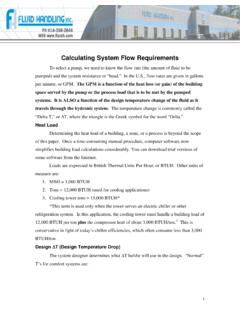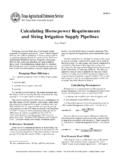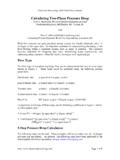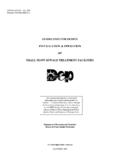Transcription of 0’/.%’()#-(1#$’2%.-’3( 4,05,6(,$7(#/8.-(9&$,$&,+(
1 Economics of Solar Electric Systems !2009, Andy Black. All rights reserved. July 2009 - 1 of 19 Solar electric systems can be a good financial investment for homeowners and businesses, depending on a variety of factors including system performance, electric rates, favorable utility rate structures, and incentives. Several US states have the right combination of conditions to strongly encourage end-consumer investment in solar electric systems based on economics alone. In places where solar is economically attractive, rates of return from 9% to 15% or better are common. If financed, the monthly net loan cost is usually less than the monthly utility bill savings. And if the home is sold, the solar system should increase the resale value by more than the system cost to install. The above claims are big, so rigorous treatment and critical analyses from several angles including Compound Annual Rate of Return, Cash Flow, Lifecycle Payback, and Appraisable Resale Value need to be considered to do a fair assessment.
2 Using the above analysis methods helps compare the solar investment to other investments on an even basis. IN THIS ARTICLE: ! What factors need to be considered to determine the economic payoff of solar, including rates, rate structures, systems performance, solar RECs, and incentives ! How to test the economic value in the ways listed above This article also includes Policy Discussion paragraphs to help individuals and policy makers in locations without strong economics understand the issues around creating solar-friendly policies, which motivate and leverage individual investment. WHY DOES SOLAR PAY OFF NOW? Good system performance, high electric rates, Net Metering and Time-Of-Use rate structures, Solar Renewable Energy Certificates (SRECs) and government incentives have contributed to the financial viability of solar electricity.
3 How these factors come together varies significantly by location. Some locations have the combination of factors that yield excellent results; in others, it makes no economic sense to go solar, especially when including the maintenance and inverter replacement costs. The key element for most analyses is the ongoing value generated by the solar system (the savings on the electric utility bill or the monetary value of system output that can be sold). A properly sited, sized, designed, and installed solar system can usually eliminate most or all of a customer s total annual electric bill. The next pages will discuss system performance, electric rate structures, and incentives. The pages following will detail how the economics can then be analyzed using Rate of Return, Payback and Lifecycle Payback, Property Value Increase, and Cash Flow when Financing.
4 SYSTEM PERFORMANCE: Lots of Sunlight is just one of the many factors that must be included in a system performance calculation. Across much of the United States, the amount of available sunlight is surprisingly uniform, with most areas within 20% of the sunlight level of Miami, Florida, as can be seen in Fig. 1. The National Renewable Energy Laboratory (NREL) has data on 239 locations across the and its territories available at: and its PVWatts calculator will determine performance for a user specified PV Equivalent Noontime Sun Hours per Day (Annual Average): Portland, OR Buffalo, NY Chicago, IL Newark, NJ Boston, MA Baltimore, MD Raleigh, NC Miami, FL Austin, TX San Francisco, CA Boulder, CO Los Angeles, CA Phoenix, AZ Fig. 1. Most locations are 20% of Miami s sunlight level.
5 Sources: NREL: and !"#$#%&"'(#)(*#+,-(!+."/-&"(*0'/.%'()#-( 1#$'2%.-'3(4,05,"6(,$7(# (9&$,$"&,+(:.'/'(By Andy Black Economics of Solar Electric Systems !2009, Andy Black. All rights reserved. July 2009 - 2 of 19 system: There are numerous loss factors that affect real system performance including component performance, wire losses, soiling, module degradation, module mismatch, system uptime and reliability, manufacturer production tolerance, and system design factors such as tilt, orientation, shading, and air flow. The California Energy Commission has produced A Guide To Photovoltaic (PV) System Design And Installation available at: and is an excellent overview of system design considerations. Fig. 2 lists performance loss factors, and the significance of potential relative losses from tilt, orientation, and shading.))))))))))
6 Inverters aren t 100% efficient, with most achieving 94-96% efficiency. Similarly, PV modules in operation put out approximately 7-14% less power at realistic operating temperatures compared to the Standard Test Conditions (STC) commonly measured in factory or laboratory settings. The State of California provides lists of module and inverter ratings at: Soiling, module degradation, and module mismatch also must be accounted for. The designer and installer have some control over wire losses, but by code, must not exceed 5%. Manufacturer production tolerance losses result from some modules having a performance specification of +X%, -Y%. If there is a negative tolerance, the customer can be sure she will be on the losing end of that bargain to at least some extent.
7 The system designer in coordination with the property owner has control over how the modules are mounted, especially how far off the roof, affecting how much airflow occurs. Thermal stagnation starts to occur with less than 6 clear airflow space behind the modules and can reduce performance up to 10% at 0 air gap. The designer and property owner also have control of solar system orientation (tilt angle or altitude above horizontal and direction or azimuth), and usually some control over shading. Shading and/or orientation are usually the #1 underestimated system performance loss factors except in locations where incentive programs specifically (directly or indirectly) include these in the calculation of the incentive to be paid. It is critical that the site analyst / installer use a shade analysis tool to accurately determine shade.
8 Quality shade tools include the Solar Pathfinder ( ), Solmetric SunEye ( ), and the Wiley ASSET ( ). It is impossible to estimate shading by eye, and even a few percent can be significant. Avoiding shading is often the most important criteria, even over selecting a south-facing roof. System availability (uptime) is dependent on system reliability and monitoring. A well-designed system with known reliable components (particularly the inverter) is important. Placing inverters in shaded, well-ventilated locations that won t accumulate ventilation-inhibiting debris will eliminate many common overheating-related problems (reduced power output due to thermal protection or shortened component lifetime). Placing the inverter close to the utility connection point will eliminate many common utility interconnection related problems (long wires can have a kind of voltage buildup in the wiring causing the inverter to think the utility is not safe to connect with, requiring it to shut down for at least 5 minutes).
9 The only way to know if a system is operating reliably is to monitor it as often as possible. Monthly observations via the electric bill savings are a crude minimum but can take 45 days or longer to make even a simple problem (sometimes only requiring a simple reset of the inverter) visible, resulting in over 12% of a year s energy to be lost. Active continuous real-time monitoring and automated alerting solutions are available that should more than pay for themselves in increased savings, peace of mind, and owner satisfaction. System Performance Factors Policy Discussion: Including predicted or actual system performance in determining the level of incentive to be paid (then actually verifying compliance with the approved design) is an excellent way for incentive agencies to improve system quality.
10 Before California adopted the requirements of the new California Solar Initiative (CSI) program, a significant fraction of sold and installed systems had major shading or other site-selection design problems, often only disclosed to the customer with a hand-wave of you ll lose a little performance due to The CSI has received a lot of criticism because of the increased level of paperwork, scrutiny and repercussions for failures from those who would rather do things the old, easy, loosey-goosey way, but in the author s opinion, the new level of accountability is the best thing that could have happened to raise the quality of installations in the state. This higher level of quality is nothing new to those in some other states such as Colorado and in some municipal utilities like SMUD.







